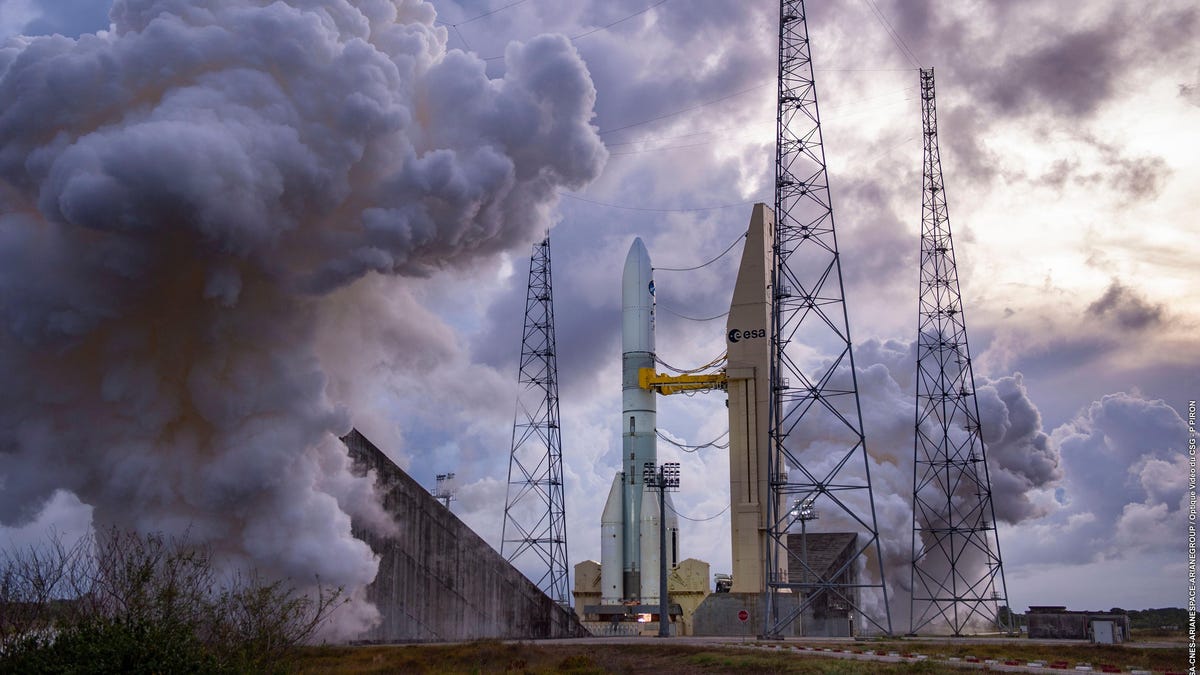The European Space Agency (ESA) has successfully conducted a full-scale rehearsal of its new Ariane 6 rocket at Europe’s Spaceport in French Guiana, marking a significant step towards the launch vehicle’s first flight.
Ground controllers performed the full-scale wet dress rehearsal on Thursday, November 23, according to an ESA press release. The exercise (carried out at Europe’s Spaceport in French Guiana) involved a complete launch countdown and a seven-minute firing of the core stage’s Vulcain 2.1 engine. This rehearsal mirrors the rocket’s performance during an actual space launch.
The test saw the Ariane 6’s core stage engine burn through nearly 150 metric tons of propellant, comprising supercooled liquid oxygen and liquid hydrogen. The Vulcain 2.1 engine, an advanced version of the Vulcain 2 that powered the recently retired Ariane 5 rocket, features a simplified, cost-effective design with technological improvements in the nozzle and ignition system, ESA explained.
The test encompassed not only the core stage but also the launch pad and operational aspects, including fueling the main and orbital stages and evaluating the thermal impact on mechanical and electrical components during launch.
“The teams from ArianeGroup, CNES and ESA have now run through every step of the rocket’s flight without it leaving Earth,” said ESA’s Director General Josef Aschbacher in the press release. “This milestone rehearsal comes after years of designing, planning, preparing, building and hard work from some of the finest space engineers in Europe. We are back on track towards resecuring Europe’s autonomous access to space.”
The expendable Ariane 6 rocket, with its two variants, Ariane 62 and Ariane 64, is integral to Europe’s future space plans. The Ariane 62, equipped with two solid rocket boosters, is tailored for government and scientific missions and capable of delivering up to 4.5 metric tons to Geostationary Transfer Orbit (GTO) and 10 metric tons to Low Earth Orbit (LEO). The more robust Ariane 64, sporting four solid rocket boosters, is meant for commercial satellite operators. This variant boasts an impressive payload capacity, able to transport up to 11.5 metric tons to GTO and 20 metric tons to LEO (by comparison, SpaceX’s fully reusable Falcon Heavy can deliver 63.8 metric tons to LEO).
French company Arianespace is building the 203-foot-tall (62-meter-tall) rocket on behalf of ESA. The inaugural launch of Ariane 6, initially slated for 2020, was rescheduled to late 2022, chiefly due to the covid-19 pandemic and additional technical hurdles encountered in its development. The maiden voyage of the rocket has been consistently delayed, with the most recent forecast suggesting an early 2024 launch.
Although the trial, lasting 426 seconds, did not reach the targeted 470 seconds, ESA and its partners still considered it a success. Over two hours were needed for ground operations, which included fueling the rocket’s central core and carrying out a series of qualification tests, all to ensure the launcher’s integrity and stability. The upper stage tanks were also fueled for the test, even though the upper stage engine, designed to work in space, was not part of this ground test. The CNES-managed launch pad was key in the rehearsal, employing its water deluge system to manage the intense heat generated during the test.
The Ariane 6 project has become more critical following the retirement of the Ariane 5 rocket in July and the end of ESA’s use of Soyuz rockets due to Russia’s invasion of Ukraine. These developments have left Europe without an operational home-grown rocket.
The latest rehearsal follows a series of earlier tests, including a brief ignition and switch-off of the Vulcain 2.1 engine in September and a fuel-draining test in October. The next milestone before ESA’s inaugural launch is a hot fire test of the upper stage, scheduled for December 2023 at the DLR Lampoldshausen test center in Germany.
For more spaceflight in your life, follow us on X (formerly Twitter) and bookmark Gizmodo’s dedicated Spaceflight page.

Dr. Thomas Hughes is a UK-based scientist and science communicator who makes complex topics accessible to readers. His articles explore breakthroughs in various scientific disciplines, from space exploration to cutting-edge research.








